#hurricane center
Text
Project 2025: The Battle Over NOAA’s Future
Project 2025, a conservative initiative, seeks to dismantle the National Oceanic and Atmospheric Administration (NOAA), the federal agency responsible for tracking hurricanes. This move has ignited controversy, with right-wing media portraying NOAA as a key driver of the climate change alarm industry.
Under Project 2025, the plan calls for significant changes to NOAA’s structure and functions.…

View On WordPress
0 notes
Text
chewing on big 3 kids being capable of absolutely devastating natural disasters and apocalypse-level outbursts of power.
Percy who creates hurricanes complete with lightning that pummel titans and flooding and whirlpools that can trap god-powered crocodile kaijus. Earthquakes that erupt volcanoes. Hazel who sunk an entire small island entirely on her own with her final breath, against giants and a primordial goddess of the earth.
If Nico dramatically wilts plants and cracks the ground when he's mildly stressed, and disintegrates enemies down to their skeletons with a single touch or rips their souls out of their still-living bodies, and can command armies of the undead, what happens if he tries to cause destruction? Even outside of total zombie apocalypse or insta-killing a crowd, he's shown enough geokinesis to absolutely be capable of the same destruction Percy and Hazel can manifest.
What about Jason? He can control the winds and storms. There's no way he can't create the most destructive tornadoes with casual effort that he can never justify using for the collateral damage they'd cause. With a single thought he can rip up a town and launch the remnants 50 miles out. (Jason in the center of a Dead Man Walking tornado, vortexes responding to his movements like an avatar...)
And what can anyone do to combat it? How can you fight the wind lifting everything you know and love into the sky, or floods sweeping you away, or the ground giving way beneath you? The Big 3 kids are scary because they are forces of nature, and their whims are the only thing preventing you from witnessing that at any given moment.
#pjo#percy jackson#riordanverse#hazel levesque#nico di angelo#jason grace#sorry Thalia and Bianca [pensive emoji] Thalia's probably just with Percy in hurricane-making club#cause she doesnt have the wind powers like Jason has especially cause those are probably specifically an Hera thing#and Bianca never got to show off her elemental powers u_u though she probably has equal geokinesis to her siblings#listen im thinking about Jason and tornadoes mostly okay#the mental image of *that* being how he defeated Krios in parallel to Percy making the hurricane to fight Hyperion#just tearing up half of Saturn's palace and scattering it across the Garden of the Hesperides#and the rest of the legion can barely see what's happening#they just see the tornado in the shape of a person and the shadow of Jason in the center illuminated by lightning#like YEAH maybe the legion would revere and fear him a little bit after that
687 notes
·
View notes
Text

Looking into the powerful eye of a hurricane! Beautiful but terrifying
#astronomy#nasa#astronomers#universe#astrophotography#nasa photos#nasawebb#astrophysics#outer space#hubble space telescope#national hurricane center#weather#space exploration#space station#space shuttle#spacecraft#space#james webb space telescope#space photography#space science#planetary science#science#beautiful earth#planet earth#planetary nebula#earth#astronauts#astro community#astro notes#astro observations
509 notes
·
View notes
Text
a while ago i thought about how tsubomi kind of got to have her own “i am the protagonist of my own life” moment when she chose to sit an wait for mob to meet her, knowing full well she could die, because she made a promise, but the more i think about it the more i realize the confession arc kind of gave EVERYONE a "protagonist of my own life” moment
#like. teru realizing mob wasnt the center of the world but still choosing to walk directly into a fuckin nuclear blast to calm him down#toichiro choosing for the first time in his life to prioritize his relationships with people over being the main character of the world#ritsu choosing to try to be the hero and take mobs bouquet rather than stand there and become a tragic backstory#reigen knowing he was going to die doing it and still choosing to run directly into a hurricane to correct his mistake#mp100#mob psycho 100#tsubomi takane
326 notes
·
View notes
Text
Center for Great Apes calls for support after Hurricane Ian:
Thank you for all of your well wishes and positive pant hoots and long-calls!

We received a direct hit from Hurricane Ian. All of the apes and staff are safe, but the grounds will need significant clean up.
A few of the big oak trees, pines, and bamboo have come down along with some perimeter fences, but most of the damage is from flooding, limbs down, and debris.
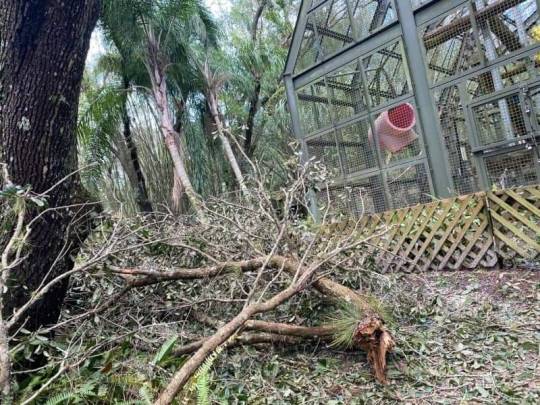
The sanctuary does not have power, water, or phone service as of right now, but we have generators running a short time to give us water to clean.

While our apes are safe they are still stuck inside their nighthouses until the debris is cleared from their outdoor habitats.

We only have a skeleton staff crew since some of our staff can't get to us because of closed roads and flooding. However, the staff here have worked hard to clear paths and ape habitats.
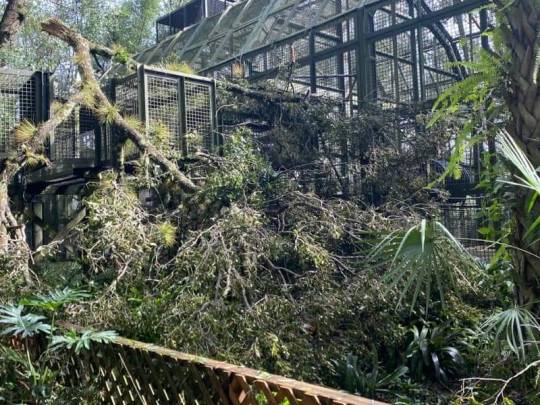
We could really use your help with clean up. If you would like to donate, please use our website here:
Donate here
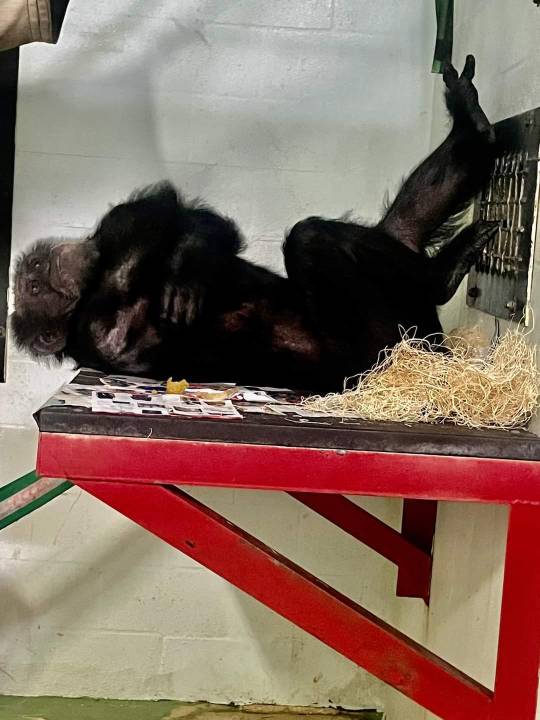
Because we don't have power or phone service, our main office is closed. Please contact our Donor Programs Coordinator, Lauren at [email protected] if you have questions that need immediate assistance.
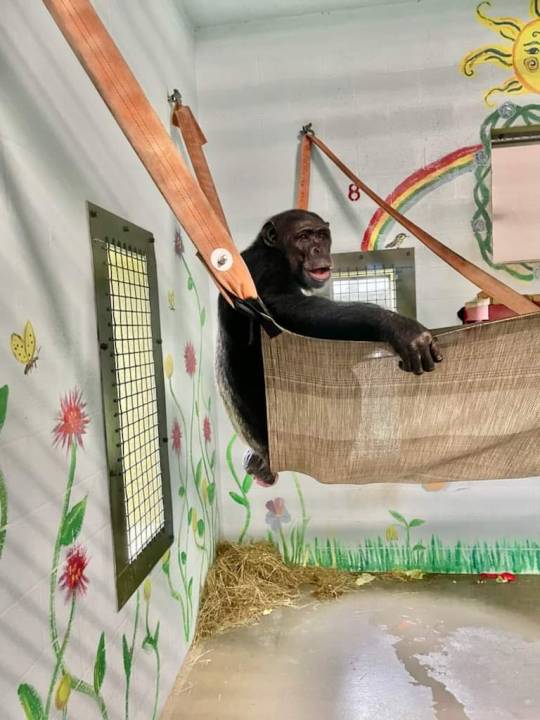
Source
778 notes
·
View notes
Text
Zoë Schlanger at The Atlantic:
In the United States, as in most other countries, weather forecasts are a freely accessible government amenity. The National Weather Service issues alerts and predictions, warning of hurricanes and excessive heat and rainfall, all at the total cost to American taxpayers of roughly $4 per person per year. Anyone with a TV, smartphone, radio, or newspaper can know what tomorrow’s weather will look like, whether a hurricane is heading toward their town, or if a drought has been forecast for the next season. Even if they get that news from a privately owned app or TV station, much of the underlying weather data are courtesy of meteorologists working for the federal government.
Charging for popular services that were previously free isn’t generally a winning political strategy. But hard-right policy makers appear poised to try to do just that should Republicans gain power in the next term. Project 2025—a nearly 900-page book of policy proposals published by the conservative think tank the Heritage Foundation—states that an incoming administration should all but dissolve the National Oceanic and Atmospheric Administration, under which the National Weather Service operates. Donald Trump has attempted to distance himself from Project 2025, but given that it was largely written by veterans of his first administration, the document is widely seen as a blueprint for a second Trump term.
NOAA “should be dismantled and many of its functions eliminated, sent to other agencies, privatized, or placed under the control of states and territories,” Project 2025 reads. The proposals roughly amount to two main avenues of attack. First, it suggests that the NWS should eliminate its public-facing forecasts, focus on data gathering, and otherwise “fully commercialize its forecasting operations,” which the authors of the plan imply will improve, not limit, forecasts for all Americans. Then, NOAA’s scientific-research arm, which studies things such as Arctic-ice dynamics and how greenhouse gases behave (and which the document calls “the source of much of NOAA’s climate alarmism”), should be aggressively shrunk. “The preponderance of its climate-change research should be disbanded,” the document says. It further notes that scientific agencies such as NOAA are “vulnerable to obstructionism of an Administration’s aims,” so appointees should be screened to ensure that their views are “wholly in sync” with the president’s.
The U.S. is, without question, experiencing a summer of brutal weather. In just the past week, a record-breaking hurricane brought major flooding and power outages to Texas amid an extreme-heat advisory. More than a dozen tornadoes ripped through multiple states. Catastrophic flash flooding barreled through wildfire burn scars in New Mexico. Large parts of the West roasted in life-threatening temperatures. Facing any of this without the National Oceanic and Atmospheric Administration would be mayhem. And future years are likely to be worse.
The NWS serves as a crucial point of contact in a weather crisis, alerting the public when forecasts turn dangerous and advising emergency managers on the best plan of action. So far in 2024, the NWS has issued some 13,000 severe-thunderstorm warnings, 2,000 tornado warnings, and 1,800 flash-flood warnings, plus almost 3,000 river-flood warnings, according to JoAnn Becker, a meteorologist and the president of the union that represents NWS employees.
NOAA is also home to the National Hurricane Center, which tracks storms, and the Office of Marine and Aviation Operations, whose pilots fly “hurricane hunter” planes directly into cyclones to measure their wind speed and hone the agency’s predictions. NOAA even predicts space weather. Just this past May, it forecast a severe geomagnetic storm with the potential to threaten power grids and satellites. (The most consequential outages never came to pass, but the solar storm did throw off farmers’ GPS-guided tractors for a while.)
Privatizing the weather is not a new conservative aim. Nearly two decades ago, when the National Weather Service updated its website to be more user-friendly, Barry Myers, then executive vice president of AccuWeather, complained to the press that “we work very hard every day competing with other companies, and we also have to compete with the government.” In 2005, after meeting with a representative from AccuWeather, then-Senator Rick Santorum introduced a bill calling for the NWS to cease competition with the private sector, and reserve its forecasts for commercial providers. The bill never made it out of committee. But in 2017, Trump picked Myers to lead NOAA. (Myers withdrew his nomination after waiting two years for Senate confirmation.)
Funding for many of NOAA’s programs could plummet in 2025, and the agency already suffers from occasional telecommunications breakdowns, including a recent alert-system outage amid flooding in the Midwest. It is also subject to political pressures: In 2019, the agency backed then-President Trump’s false claim (accompanied by a seemingly Sharpie-altered map) that Hurricane Dorian was headed for Alabama. Private companies might be better funded and, theoretically, less subject to political whims. They can also use supercomputing power to hone NOAA’s data into hyperlocal predictions, perhaps for an area as small as a football stadium. Some, including AccuWeather, use their own proprietary algorithms to interpret NWS data and produce forecasts that they claim have superior accuracy. (Remember, though: Without NWS data, none of this would happen.)
[...]
The NWS also has perks that a private system would be hard-pressed to replicate, including a partnership with the World Meteorological Organization, which allows the U.S. access to a suite of other countries’ weather models. International collaboration proved crucial in 2012, when Hurricane Sandy was still churning in the Atlantic Ocean. Initially, the American model predicted, incorrectly, that the storm would turn away from the East Coast. But the European model accurately forecast a collision course, which bought emergency managers in the U.S. crucial time to prepare before Sandy made ferocious landfall in New Jersey.
Project 2025 could have an impact on how accurate and precise weather forecasts are delivered, since NOAA and NWS could be significantly altered.
This is one of many reasons why we must vote Blue up and down the line.
See Also:
Daily Kos: Project 2025 will affect every part of life. Even weather updates
#Project 2025#Weather#NOAA#NWS#National Oceanic and Atmospheric Association#National Weather Service#National Hurricane Center#AccuWeather#Barry Myers#Rick Santorum#Climate Change
32 notes
·
View notes
Text
Atlantic Tropical Weather Outlook issued by the National Hurricane Center in Miami, FL, USA
2024-07-26, 14:00 EDT

Near the Lesser and Greater Antilles: An area of disturbed weather over the central tropical Atlantic Ocean is expected to interact with an approaching tropical wave during the next several days. Some development of this system will be possible while it approaches the Lesser Antilles during the early to middle part of next week and moves generally west-northwestward near the Greater Antilles toward the latter part of the week.
* Formation chance through 48 hours...low...near 0 percent.
* Formation chance through 7 days...low...20 percent.
$$ Forecaster Berg
#bot post#meteorology#weather#tropical weather#tropical storm#tropical depression#hurricane#atlantic#atlantic ocean#caribbean#gulf of mexico#noaa#national oceanic and atmospheric administration#nhc#national hurricane center
12 notes
·
View notes
Text
I'm glad everyone now is more openly condemning Israel but it took 7 aid workers to be murdered over 30,000 Palestinians for everyone to open their eyes.
No one is safe in Gaza and the West Bank, not even aid workers.
#rip jacob flickinger#he distributed meals to people affected by a hurricane in my country 💔#free palestine#palestine#gaza strip#world center kitchen
17 notes
·
View notes
Text
Officially finished my comm batch today! Treating myself to a little break so I can relax and also focus on dragons and aging.
#as if I wasn't already before but *gestures vaguely* you know. 😌#aev rambles#honestly contemplated if i want to do another batch or not before veilguard bc i want to make sure i don't have anything on my schedule#before the release. but i also need to be realistic LOL i likely will. for bills and it's hurricane season. anything could happen.#but i will say if i do another small batch i think i want it to be dragon age ocs centered if possible. maybe. would be fun :3
15 notes
·
View notes
Text
Climate experts fear Donald Trump will follow a blueprint created by his allies to gut the National Oceanic and Atmospheric Administration (NOAA), disbanding its work on climate science and tailoring its operations to business interests.
Joe Biden’s presidency has increased the profile of the science-based federal agency but its future has been put in doubt if Trump wins a second term and at a time when climate impacts continue to worsen.
The plan to “break up NOAA” is laid out in the Project 2025 document written by more than 350 rightwingers and helmed by the Heritage Foundation. Called the Mandate for Leadership: The Conservative Promise, it is meant to guide the first 180 days of presidency for an incoming Republican president.
The document bears the fingerprints of Trump allies, including Johnny McEntee, who was one of Trump’s closest aides and is a senior adviser to Project 2025. “The National Oceanographic [sic] and Atmospheric Administration (NOAA) should be dismantled and many of its functions eliminated, sent to other agencies, privatized, or placed under the control of states and territories,” the proposal says.
That’s a sign that the far right has “no interest in climate truth”, said Chris Gloninger, who last year left his job as a meteorologist in Iowa after receiving death threats over his spotlighting of global warming.
The guidebook chapter detailing the strategy, which was recently spotlighted by E&E News, describes NOAA as a “colossal operation that has become one of the main drivers of the climate change alarm industry and, as such, is harmful to future US prosperity”. It was written by Thomas Gilman, a former Chrysler executive who during Trump’s presidency was chief financial officer for NOAA’S parent body, the Commerce Department.
Gilman writes that one of NOAA’S six main offices, the Office of Oceanic and Atmospheric Research, should be “disbanded” because it issues “theoretical” science and is “the source of much of Noaa’s climate alarmism”. Though he admits it serves “important public safety and business functions as well as academic functions”, Gilman says data from the National Hurricane Center must be “presented neutrally, without adjustments intended to support any one side in the climate debate”.
But NOAA’S research and data are “largely neutral right now”, said Andrew Rosenberg, a former NOAA official who is now a fellow at the University of New Hampshire. “It in fact basically reports the science as the scientific evidence accumulates and has been quite cautious about reporting climate effects,” he said. “It’s not pushing some agenda.”
The rhetoric harkens back to the Trump administration’s scrubbing of climate crisis-related webpages from government websites and stifling climate scientists, said Gloninger, who now works at an environmental consulting firm, the Woods Hole Group.
“It’s one of those things where it seems like if you stop talking about climate change, I think that they truly believe it will just go away,” he said. “They say this term ‘climate alarmism’ … and well, the existential crisis of our lifetime is alarming.”
NOAA also houses the National Weather Service (NWS), which provides weather and climate forecasts and warnings. Gilman calls for the service to “fully commercialize its forecasting operations”.
He goes on to say that Americans are already reliant on private weather forecasters, specifically naming AccuWeather and citing a PR release issued by the company to claim that “studies have found that the forecasts and warnings provided by the private companies are more reliable” than the public sector’s. (The mention is noteworthy as Trump once tapped the former CEO of AccuWeather to lead NOAA, though his nomination was soon withdrawn.)
The claims come amid years of attempts from US conservatives to help private companies enter the forecasting arena – proposals that are “nonsense”, said Rosenberg.
Right now, all people can access high-quality forecasts for free through the NWS. But if forecasts were conducted only by private companies that have a profit motive, crucial programming might no longer be available to those in whom business executives don’t see value, said Rosenberg.
“What about air-quality forecasts in underserved communities? What about forecasts available to farmers that aren’t wealthy farmers? Storm-surge forecasts in communities that aren’t wealthy?” he said. “The frontlines of most of climate change are Black and brown communities that have less resources. Are they going to be getting the same service?”
Private companies like Google, thanks to technological advancements in artificial intelligence, may now indeed be producing more accurate forecasts, said Andrew Blum, author of the 2019 book The Weather Machine: A Journey Inside the Forecast. Those private forecasts, however, are all built on NOAA’S data and resources.
Fully privatizing forecasting could also threaten the accuracy of forecasts, said Gloninger, who pointed to AccuWeather’s well-known 30- and 60-day forecasts as one example. Analysts have found that these forecasts are only right about half the time, since peer-reviewed research has found that there is an eight- to 10-day limit on the accuracy of forecasts.
“You can say it’s going to be 75 degrees out on May 15, but we’re not at that ability right now in meteorology,” said Gloninger. Privatizing forecasting could incentivize readings even further into the future to increase views and profits, he said.
Commercializing weather forecasts – an “amazing example of intergovernmental, American-led, postwar, technological achievement” – would also betray the very spirit of the endeavor, said Blum.
In the post-second world war era, John F. Kennedy called for a global weather-forecasting system that relied on unprecedented levels of scientific exchange. A privatized system could potentially stymie the exchange of weather data among countries, yielding less accurate results.
The founding of weather forecasting itself showcases the danger of giving profit-driven companies control, said Rosenberg. When British V. Adm Robert FitzRoy first introduced Britain to the concept of forecasts during Victorian times, he was often bitterly attacked by business interests. The reason: workers were unwilling to risk their lives when they knew dangerous weather was on the horizon.
“The ship owners said, well, that means maybe I lost a day’s income because the fishermen wouldn’t go out and risk their lives when there was a forecast that was really bad, so they didn’t want a forecast that would give them a day’s warning,” Rosenberg said. “The profit motive ended up trying to push people to do things that were dangerous … there’s a lesson there.”
#us politics#news#the guardian#2024#project 2025#donald trump#biden administration#National Oceanic and Atmospheric Administration#Mandate for Leadership: The Conservative Promise#Johnny McEntee#Chris Gloninger#global warming#climate crisis#climate change#department of commerce#Office of Oceanic and Atmospheric Research#National Hurricane Center#Andrew Rosenberg#National Weather Service#AccuWeather
12 notes
·
View notes
Text
Hurricane Beryl
This morning, Hurricane Beryl has hit Texas including my hometown, Houston. Pray for me and my family's safety.
7 notes
·
View notes
Text

its not even raining anymore...
4 notes
·
View notes
Text

In September, Hurricane Maria swept through Puerto Rico killing thousands—including Ocasio-Cortez’s grandfather.
#In September#Hurricane Maria swept through Puerto Rico killing thousands—including Ocasio-Cortez’s grandfather.#carolina hurricanes#hurricane beryl#national hurricane center#hurricane season#hurricane maria#puerto rico#ausgov#politas#auspol#tasgov#taspol#australia#fuck neoliberals#neoliberal capitalism#anthony albanese#albanese government#usa news#usa is a terrorist state#usa politics#usa#american indian#america#american#class war#genocide joe#anti joe biden#joe biden#president biden
4 notes
·
View notes
Text
"Brian Fork, Chief Executive Officer of Hurricanes Holdings, LLC, today announced that the Centennial Authority has approved an arena naming rights agreement between Lenovo and the Carolina Hurricanes to rename the team’s home arena “Lenovo Center” beginning in September. The agreement will run for 10 years, through the 2033-34 National Hockey League season."
2 notes
·
View notes
Text
By Jon Queally
Common Dreams
July 1, 2024
"The climate crisis is here. This is an emergency. Politicians need to start acting like it."
Meteorologists, climate campaigners, and extreme weather experts expressed shock and horror Sunday as Hurricane Beryl exploded into an "extremely dangerous" Category 4 storm as it headed into the warm waters of the southern Caribbean with a level of intensification characterized as unprecedented.
The National Hurricane Center on Sunday morning called it a "very dangerous situation" due to "potentially catastrophic hurricane-force winds, a life-threatening storm surge, and damaging waves" for the numerous mainland and island nations in Beryl's path.
According to the NHC, the Windward Islands of St. Vincent, the Grenadines, and Granada will be the first at highest risk from the storm as well as St. Lucia and Barbados. People on those islands and elsewhere in the region were told that all preparations for the storm "should be rushed to completion" without delay.
Weather Underground reports that subsequent locations that may face Beryl's wrath later this week could be Jamaica, the Cayman Islands, Belize and Mexico's Yucatan Peninsula, though noted "there's uncertainty in that exact track" of the hurricane as detailed in the following graphic:

Possible storm tracks for Hurricane Beryl. (Source: Weather Underground / wunderground.com)
Citing records going back to 1851, the Washington Post reported Sunday that there "is no precedent for a storm to intensify this quickly, nor reach this strength, in this part of the ocean during the month of June."

Eric Blake, a hurricane expert, said that Beryl on Sunday was "rewriting the history books in all the wrong ways," as he urged people in its path to "be very safe and take this hurricane seriously" as "very few will have experienced a hurricane this strong" on those islands.

"This is unreal," said Nahel Belgherze, a journalist focused on extreme weather. "Hurricane Beryl continues to defy all known logic, now becoming the first June Category 4 hurricane ever recorded in the Atlantic Basin. I can't even stress enough just how completely absurd that storm is."
"The climate crisis is here," said the Sunrise Movement in a social media post showing the extreme power and historic nature of Hurricane Beryl. "This is an emergency. Politicians need to start acting like it."
The group took the opportunity to re-share its petition calling on President Joe Biden to "declare a climate emergency" as a way to unlock federal funds and escalate the government's response to the crisis of fossil fuels that are the main driving of surging global temperatures.

In May, the U.S. National Oceanic and Atmospheric Administration (NOAA) predicted that the 2024 hurricane season—which officially runs from June 1 to the end of November—would be "extraordinary" and "above-normal," largely due to rising ocean temperatures attributable to human-caused global warming couple with La Niña conditions.
5 notes
·
View notes
Text

Went on a camping trip down to south Florida, starting in the everglades
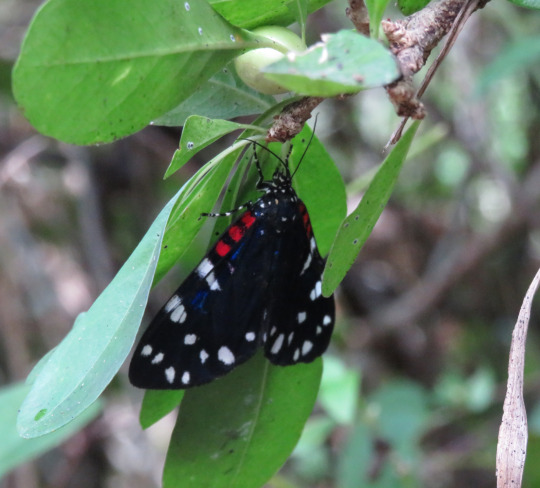

We were looking for snakes and American crocodiles, but we did find this day moth and tree snail


Plus a couple nocturnal critters settling down for a nice days sleep




Lots of high quality birds in the swamp



Saw frigate birds in the Dry Tortugas, but they mostly hung motionless and effortlessly high in the air like low poly videogame background birds

Had to flee back north early ahead of Nikole. Managed to catch a glimpse of this bark anole when we stopped for breakfast, but all the iguanas were hiding.

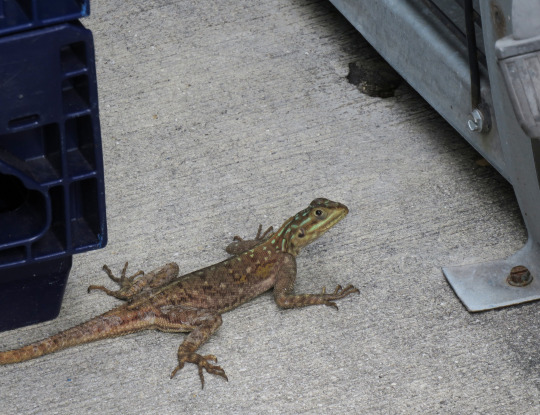

Tons of introduced rock agamas calling this gas station home, and a nearby rooster hung out with a flock of grackles. Was hoping to see more exotic reptiles around Miami, but perhaps another time.
#long post#travel log#now I'm sick#gonna be so mad if I dodged Covid for 2 years and finally lost because of a trip centered around outdoor activities#The Dry Tortugas was great but not really full of photography opportunities unless you like ruins#Previous hurricane destroyed a lot of plants so he was just like#pls don't step on any of my plants I don't have many left#There was a full moon so we couldn't see the stars except surprise there was a lunar eclipse actually#no light pollution so we saw the milky way and a shooting star that shattered into fragments as it burned up on entry#also#apparently a lot of Cuban refugees land there so the head ranger guy didn't know much about the wildlife so one got the impression#that tourists were an unfortunate inconvenience for him personally when he had a lot of other stuff more important to be worrying about#I don't think many would want to come here if America lifted the embargo strangling their country#so we just invent a crisis for another independent country because Communism Bad#and then treat the poor folks fleeing the conditions we created like criminals#all because if a country was doing even moderately okay without capitalism it'd be bad for the shareholders I guess#anyway the fort was cool but I don't know how to photograph ruins well
48 notes
·
View notes